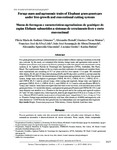Por favor, use este identificador para citar o enlazar este ítem:
http://www.alice.cnptia.embrapa.br/alice/handle/doc/1064494| Título: | Forage mass and agronomic traits of Elephant grass genotypes under free-growth and conventional cutting systems. |
| Autor: | GIMENES, F. M. de A.  BERNDT, A.   MATEUS, G. P.   LEDO, F. J. da S.   DEMARCHI, J. J. A. de A.   GIACOMINI, A. A.   GERDES, L.   BATISTA, K.   |
| Afiliación: | Flávia Maria de Andrade Gimenes, IZ - SP; ALEXANDRE BERNDT, CPPSE; Gustavo Pavan Mateus, APTA; FRANCISCO JOSE DA SILVA LEDO, CNPGL; João José Assumpção de Abreu Demarchi, IZ - SP; Alessandra Aparecida Giacomini, IZ - SP; Luciana Gerdes, IZ- SP; Karina Batista, IZ - SP. |
| Año: | 2016 |
| Referencia: | Semina: Ciências Agrárias, v. 37, n. 4, supl. 1, p. 2577-2588, 2016. |
| Descripción: | Abstract Few grass genotypes with high yield potential are used as fodder in Brazil, making it necessary to develop new cultivars. In this study, we compared tiller density, forage mass, and agronomic traits across 12 Elephant grass (Pennisetum purpureum Schum.) genotypes under free-growth and conventional cutting systems at the Agência Paulista de Técnologia dos Agronegócios (APTA), Andradina, São Paulo, Brazil. The experimental design of the two trials was three replicates of a randomized complete block, each experimental unit consisting of 37.5-m2 plots with five rows spaced 1.5 m apart. We estimated tiller density 30, 60, and 150 days after planting (DAP), and 90 days after cut (DAC), and harvested the grass 150 DAP and 90 DAC for determination of forage mass and agronomic traits. In the free-growth system, forage mass was highest in genotypes CNPGL 00-155-2, CNPGL 92-41-1, CNPGL 92-51-1, and CNPGL 96-21-1 and in cultivar Guaçu. After cutting and regrowth, forage mass was highest in genotypes CNPGL 93-41-1, CNPGL 92-41-1, and CNPGL 91-11-2 and in cultivars Mineiro IPEACO, Guaçu, and Pioneiro. Stem mass was higher than leaf mass in the two trials, with leaf/stem ratio in most genotypes below 1.0. Aerial tiller density was highest for genotypes Pioneiro and CNPGL 00-155-2, and stem diameter was smallest in cv. Pioneiro in the free-growth and in the cutting and regrowth systems (9.7 and 7.62 mm, respectively). After regrowth, plant height ranged from 0.56 m in cv. Guaçu to 2.0 m in cv. Mineiro IPEACO and the mean number of internodes.stem-1 ranged from 2.1 in cv. Guaçu to 7.4 in cv. Pioneiro. Forage mass correlated positively with basal tiller density (r =0.4096) and negatively with stem diameter (r =-0.4879) in the free-growth trial, but relationships were not significant after regrowth. |
| Thesagro: | Pennisetum Purpureum |
| NAL Thesaurus: | clones height hybrids |
| Palabras clave: | Tiller density Leaf/stem ratio |
| Tipo de Material: | Artigo de periódico |
| Acceso: | openAccess |
| Aparece en las colecciones: | Artigo em periódico indexado (CNPGL)  |
Ficheros en este ítem:
| Fichero | Descripción | Tamaño | Formato | |
|---|---|---|---|---|
| Cnpgl2016SeminaForage.pdf | 310,56 kB | Adobe PDF |  Visualizar/Abrir |









